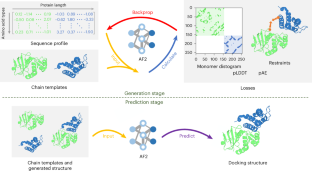利用 ColabDock 进行带有实验约束的蛋白质-蛋白质对接的综合结构预测
IF 18.8
1区 计算机科学
Q1 COMPUTER SCIENCE, ARTIFICIAL INTELLIGENCE
引用次数: 0
摘要
蛋白质复合物结构预测在药物发现和抗体设计等各种应用中发挥着重要作用。然而,由于预测精度有限,预测与实验之间经常出现不一致。在此,我们提出了一个通用框架 ColabDock,该框架调整了深度学习结构预测模型,以整合不同形式和来源的实验约束,而无需进一步的大规模再训练或微调。利用生成-预测架构和训练有素的排序模型,ColabDock不仅在模拟残基和表面约束的复杂结构预测方面优于HADDOCK和使用AlphaFold2作为结构预测模型的ClusPro,而且在核磁共振化学位移扰动和共价标记辅助的复杂结构预测方面也优于HADDOCK和ClusPro。它还能利用仿真界面扫描约束条件辅助抗体-抗原界面预测,这些约束条件可通过深度突变扫描等实验获得。作为一个统一的框架,我们希望 ColabDock 能够帮助弥合实验和计算蛋白质科学之间的差距。本文章由计算机程序翻译,如有差异,请以英文原文为准。


Integrated structure prediction of protein–protein docking with experimental restraints using ColabDock
Protein complex structure prediction plays important roles in various applications, such as drug discovery and antibody design. However, due to limited prediction accuracy, there are frequent inconsistencies between the predictions and the experiments. Here we present ColabDock, a general framework adapting deep learning structure prediction models to integrate experimental restraints of different forms and sources without further large-scale retraining or fine tuning. With a generation–prediction architecture and trained ranking model, ColabDock outperforms HADDOCK and ClusPro using AlphaFold2 as the structure prediction model, not only in complex structure predictions with simulated residue and surface restraints but also in those assisted by nuclear magnetic resonance chemical shift perturbation as well as covalent labelling. It also assists antibody–antigen interface prediction with emulated interface scan restraints, which could be obtained by experiments such as deep mutational scanning. As a unified framework, we hope that ColabDock can help to bridge the gap between experimental and computational protein science. Despite rapid developments in predicting the complex structures of proteins, there are still inconsistencies between predictions and experiments. Feng et al. developed ColabDock, a general framework for deep learning models that integrates various experimental restraints and improves complex interface prediction, including antibody–antigen interactions.
求助全文
通过发布文献求助,成功后即可免费获取论文全文。
去求助
来源期刊

Nature Machine Intelligence
Multiple-
CiteScore
36.90
自引率
2.10%
发文量
127
期刊介绍:
Nature Machine Intelligence is a distinguished publication that presents original research and reviews on various topics in machine learning, robotics, and AI. Our focus extends beyond these fields, exploring their profound impact on other scientific disciplines, as well as societal and industrial aspects. We recognize limitless possibilities wherein machine intelligence can augment human capabilities and knowledge in domains like scientific exploration, healthcare, medical diagnostics, and the creation of safe and sustainable cities, transportation, and agriculture. Simultaneously, we acknowledge the emergence of ethical, social, and legal concerns due to the rapid pace of advancements.
To foster interdisciplinary discussions on these far-reaching implications, Nature Machine Intelligence serves as a platform for dialogue facilitated through Comments, News Features, News & Views articles, and Correspondence. Our goal is to encourage a comprehensive examination of these subjects.
Similar to all Nature-branded journals, Nature Machine Intelligence operates under the guidance of a team of skilled editors. We adhere to a fair and rigorous peer-review process, ensuring high standards of copy-editing and production, swift publication, and editorial independence.
 求助内容:
求助内容: 应助结果提醒方式:
应助结果提醒方式:


